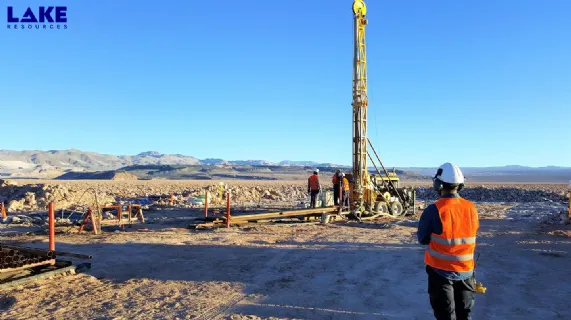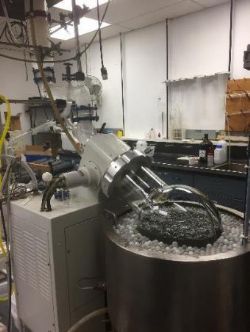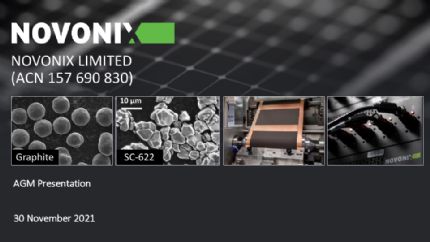
High Purity Battery Quality Lithium Carbonate - Kachi Brines
Brisbane, Oct 20, 2020 AEST (ABN Newswire) - Clean lithium developer Lake Resources NL ( ASX:LKE) (
ASX:LKE) ( LK1:FRA) (
LK1:FRA) ( LLKKF:OTCMKTS) is pleased to announce the high purity results from tests carried out at Hazen Research Inc (Hazen), a world renowned independent process laboratory.
LLKKF:OTCMKTS) is pleased to announce the high purity results from tests carried out at Hazen Research Inc (Hazen), a world renowned independent process laboratory.
- High purity 99.97% lithium carbonate produced by Hazen Research Inc from lithium chloride produced at the Lilac Solutions pilot plant module from Lake's Kachi brines.
- Samples have very low impurities; Lake expects this product to be attractive for the battery market.
- Lake Resources is confident of replicating these results at full production
- Sample production by Hazen to continue with samples expected to be sent to Novonix and supply chain customers in Asia and Europe for battery tests, anticipated this quarter.
Lithium Carbonate Results
Lake' technology partner, Lilac Solutions Inc (Lilac) has already demonstrated the production of high purity lithium chloride eluate using its proprietary ion-exchange direct lithium extraction method (DLE) at pilot plant module scale in California (refer ASX announcement 3 July 2020). Samples of this lithium chloride were further processed into lithium carbonate by Hazen in Colorado, USA. Hazen conducted a series of tests aimed at optimizing lithium carbonate quality while maintaining a simple flowsheet. Conventional treatment methods, including evaporation, treatment with sodium hydroxide and soda ash, ion exchange, and precipitation, were used (see Appendix 1). This process optimization was a critical step prior to production of larger volumes of high purity lithium carbonate samples.
The tests at Hazen establish that very high purity 99.97% lithium carbonate with low impurities can be produced from Kachi brines.
To ensure accuracy, a number of analytical techniques were employed to verify the lithium carbonate grade and the low impurities levels including inductively coupled plasma spectrometry and titration, both of which are accepted assaying techniques. Sample preparation and analytical methods are included in Appendix 1*.
Very Low Impurities
Samples produced by Hazen show a 70% reduction in the overall level of impurities compared to Lake's earlier lithium carbonate production (99.9% lithium carbonate, refer ASX announcement 9 January 2020) and a significant 94% reduction in impurities compared with 99.5% lithium carbonate, widely accepted as "battery grade" in the current market. Notably, the results include very low metal and cation impurities including iron (Fe) and boron (B).
Lake expects this product to be highly attractive for the lithium-ion battery market where low impurities is a key factor in determining battery quality.
Premium Pricing Potential
Pricing in the lithium carbonate market is largely determined by lithium carbonate grade and the level and type of impurities. The results achieved by Lilac and Hazen with Kachi brine suggest the potential to achieve substantially higher prices than previously envisaged. The Pre-Feasibility Study (PFS) (refer ASX announcement 30 April 2020) was based on achieving 99.9% lithium carbonate and a fixed selling price of US$11,000/t.
Next steps
Hazen will continue to produce lithium carbonate samples over the coming weeks, targeting 5kg to 6kg in this round. Samples will be sent to Novonix Limited ( ASX:NVX), to be tested together with commercial battery cathode precursor materials in NMC622 batteries (refer ASX announcement 27 August 2020). Novonix is currently developing "million mile" battery technologies with revolutionary anode and cathode materials. Samples will also be sent to other potential off-take partners in Asia and Europe.
ASX:NVX), to be tested together with commercial battery cathode precursor materials in NMC622 batteries (refer ASX announcement 27 August 2020). Novonix is currently developing "million mile" battery technologies with revolutionary anode and cathode materials. Samples will also be sent to other potential off-take partners in Asia and Europe.
Scale-up from Pilot Plant Module to Production Scale
Lilac's pilot plant module treatment of Kachi brine to produce lithium chloride solution was conducted at roughly 1,000x the earlier laboratory bench-scale tests. The scale-up from the pilot module to full production scale modules is expected to be a relatively small, 3-5 times, depending on the final module design. The PFS was based on utilizing a series of modules to produce 25,500 tonnes per annum lithium carbonate equivalent. These successful pilot module tests from brine to final product, provide the confidence to replicate the results at planned production scale. Further, the use of direct lithium extraction as designed by Lilac, allows for consistent product quality and for ready production scalability.
Definitive Feasibility Study
The results of Hazen's process optimization, forthcoming battery tests, updated price expectations, and decisions on final plant module capacity, will be incorporated into the forthcoming Definitive Feasibility Study.
Lake's ambition is to sustainably produce the cleanest quality lithium carbonate at scale for use in the fast-growing battery market. Lake's Managing Director, Steve Promnitz said: "These are excellent results. We are very pleased not only with the very high purity lithium carbonate grades, but also with the very low impurities. This is a function of the purity of the raw brine at our Kachi project, combined with the excellent work done by Lilac Solutions over the past two years, and by Hazen Research. Lake has a clean process, based on standard chemical processing techniques, which is readily scalable. The environmental footprint is small. Based on the results reported today, we believe Lake is well placed to deliver among the highest quality, sustainable, clean lithium carbonate products to the EV and energy storage market".
*To view tables and figures, please visit:
https://abnnewswire.net/lnk/Q1ZJLT1R
About Lake Resources NL
 Lake Resources NL (ASX:LKE) (OTCMKTS:LLKKF) is a clean lithium developer utilising state-of-the-art ion exchange extraction technology for production of sustainable, high purity lithium from its flagship Kachi Project in Catamarca Province within the Lithium Triangle in Argentina among three other projects covering 220,000 ha.
Lake Resources NL (ASX:LKE) (OTCMKTS:LLKKF) is a clean lithium developer utilising state-of-the-art ion exchange extraction technology for production of sustainable, high purity lithium from its flagship Kachi Project in Catamarca Province within the Lithium Triangle in Argentina among three other projects covering 220,000 ha.
This ion exchange extraction technology delivers a solution for two rising demands - high purity battery materials to avoid performance issues, and more sustainable, responsibly sourced materials with low carbon footprint and significant ESG benefits.
| ||
|















